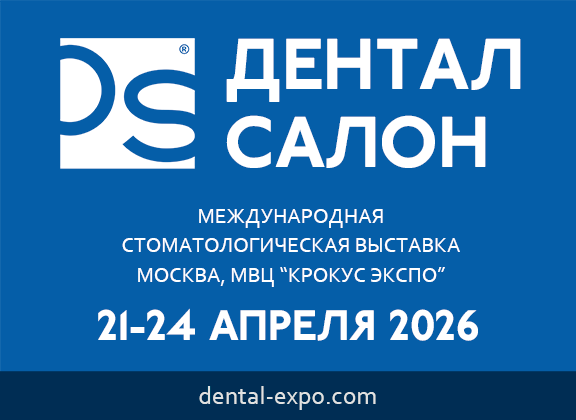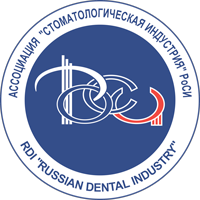DOI:
10.37988/1811-153X_2023_4_64Microbial adhesion to samples of complete removable dentures of polymethylmethacrylate-polyethyleneterephthalate composition
Downloads
Abstract
The processes of primary adhesion to structural materials determine the initial stage of formation of aggressive microbial biofilms, which, in turn, play an extremely important role in the development of infectious complications. The aim of the study is to evaluate the adhesive activity of various representatives of oral microbiota to samples of dental materials made of polyethylene terephthalate (PET) and polymethyl methacrylate (PMMA) taking into account their hydrophobic properties, as well as to assess the relationship between bacteria-substrate pairs in the combination of PET and PMMA.Materials and methods.
Based on a significance level of 0.05 and power of 0.8 the study produced 16 samples of each material (n=80): PET; PMMA (baseline); PMMA (garnished); combination of PET and PMMA materials (baseline); combination of PET and PMMA materials (garnished). The primary adhesion index (AI) was calculated and compared to samples of test strains of S. sanguinis, A. naeslundii, N. sicca, P. micra, P. gingivalis, F. periodonticum, C. albicans and C. krusei isolated from periodontal pockets of patients with chronic periodontitis, and the degree of hydrophobicity of these microbes was calculated.
Results.
Adhesion of representatives of normobiota with hydrophobic properties (A. naeslundii) to PET was minimal (AI=0.27±0.03, p<0.05). The lowest AI values were determined for strains with amphiphilic and hydrophilic properties to PMMA (p<0.05). Optimal AI (0.52±0.03, p<0.05) was found for the combination of PET and PMMA (garnished).
Conclusions.
The results obtained in the presented study allow us to conclude about the role of hydrophobicity of representatives of the oral microbiome, as well as the chemical nature of structural materials and their combinations as factors influencing the primary adhesion of microorganisms.
Key words:
denture bases, denture, complete, immediate, polyethylene terephthalates, polymethyl methacrylate, tooth, artificialFor Citation
[1]
Chizhmakov E.A., Tsareva T.V., Podporin M.S., Ippolitov E.V., Tlupov I.V., Balagova Z.E., Timoshchenko M.V., Arutyunov A.S. Microbial adhesion to samples of complete removable dentures of polymethylmethacrylate-polyethyleneterephthalate composition. Clinical Dentistry (Russia). 2024; 26 (4): 64—70. DOI: 10.37988/1811-153X_2023_4_64
References
- Tsimbalistov A.V., Soboleva A.V., Tsarev V.N., Zolotnitsky I.V., Dubova L.V., Malginov N.N., Dobrovolsky P.V., Chuev V.P., Arutyunov S.D. Clinical efficacy of removable dentures made of Nolatec photopolymeric base substance. Clinical Dentistry (Russia). 2020; 2 (94): 121—125 (In Russian). eLIBRARY ID: 43125616
- Arutyunov A.S., Tzarev V.N., Kravtsov D.V., Komov E.V. Comparative analysis of adhesion of microbial flora from the oral cavity to the base materials for polyurethane and acryl-based jaw prostheses. Russian Journal of Dentistry. 2011; 1: 19—23 (In Russian). eLIBRARY ID: 16209620
- Alqutaibi A.Y., Baik A., Almuzaini S.A., Farghal A.E., Alnazzawi A.A., Borzangy S., Aboalrejal A.N., AbdElaziz M.H., Mahmoud I.I., Zafar M.S. Polymeric denture base materials: A review. Polymers (Basel). 2023; 15 (15): 3258. PMID: 37571151
- Arutyunov A.S., Tsareva T.V., Kirakosyan L.G., Levchenko I.M. Features and significance of adhesion of bacteria and fungi of the oral cavity as the initial stage of the formation of a microbial biofilm on dental polymer materials. Stomatology. 2020; 2: 79—84 (In Russian). eLIBRARY ID: 42851810
- Ryzhova I.P., Chuev V.V., Tsimbalistov A.V., Shtana V.S., Dzhanashia V.T. Comparative analysis of microbial adhesion to traditional and new basic materials used in prosthetic dentistry. Clinical Dentistry (Russia). 2019; 3 (91): 62—64 (In Russian). eLIBRARY ID: 41188362
- Al-Dulaijan Y.A., Balhaddad A.A. Prospects on tuning bioactive and antimicrobial denture base resin materials: A narrative review. Polymers (Basel). 2022; 15 (1): 54. PMID: 36616404
- Arutyunov S.D., Ibragimov T.I., Tsarev V.N., Lebedenko I.Yu., Savkina N.I., Trefilov A.G., Arutyunov A.S., Klimashin Yu.I. Microbiological validation of the choice of basic plastic for removable dentures. Stomatology. 2002; 3: 4—8 (In Russian). eLIBRARY ID: 46305479
- Ibragimov T.I., Arutyunov S.D., Tsarev V.N., Lebedenko I.Yu., Kraveishvili S.E. Clinical and laboratory studies of bacterial adhesion to validate the choice of material for making provisional dentures for patients with periodontal diseases. Stomatology. 2002; 2: 40—44 (In Russian). eLIBRARY ID: 46288437
- Balmasova I.P., Tsarev V.N., Gvetadze R.S., Mustafaev M.S., Tsareva T.V., Malova E.S., Arutyunov D.S., Timoshchenko M.V., Kharakh Ya.N., Arutyunov S.D. Oral virome: the beginning of the path (review). Clinical Dentistry (Russia). 2023; 3: 115—124 (In Russian). eLIBRARY ID: 54509016
- Yumoto H., Hirota K., Hirao K., Ninomiya M., Murakami K., Fujii H., Miyake Y. The pathogenic factors from oral Streptococci for systemic diseases. Int J Mol Sci. 2019; 20 (18): 4571. PMID: 31540175
- Andryukov B.G., Romashko R.V., Efimov T.A., Lyapun I.N., Bynina M.P., Matosova E.V. Mechanisms of adhesive-coadhesive interaction of bacteria in the formation of a biofilm. Molecular Genetics, Microbiology and Virology. 2020; 4: 155—161 (In Russian). eLIBRARY ID: 44312344
- Gad M.M., Abualsaud R., Khan S.Q. Hydrophobicity of denture base resins: A systematic review and meta-analysis. J Int Soc Prev Community Dent. 2022; 12 (2): 139—159. PMID: 35462737
- An S., Evans J.L., Hamlet S., Love R.M. Incorporation of antimicrobial agents in denture base resin: A systematic review. J Prosthet Dent. 2021; 126 (2): 188—195. PMID: 32800329
- Paraszkiewicz K., Moryl M., Płaza G., Bhagat D., K Satpute S., Bernat P. Surfactants of microbial origin as antibiofilm agents. Int J Environ Health Res. 2021; 31 (4): 401—420. PMID: 31509014
- Monteiro D.R., de Souza Batista V.E., Caldeirão A.C.M., Jacinto R.C., Pessan J.P. Oral prosthetic microbiology: aspects related to the oral microbiome, surface properties, and strategies for controlling biofilms. Biofouling. 2021; 37 (4): 353—371. PMID: 34139899
- de Lima Burgo T.A., Rezende C.A., Bertazzo S., Galembeck A., Galembeck F. Electric potential decay on polyethylene: Role of atmospheric water on electric charge build-up and dissipation. Journal of electrostatics. 2011; 69 (4): 401—409. DOI: 10.1016/j.elstat.2011.05.005
- Silva-Dias A., Miranda I.M., Branco J., Monteiro-Soares M., Pina-Vaz C., Rodrigues A.G. Adhesion, biofilm formation, cell surface hydrophobicity, and antifungal planktonic susceptibility: relationship among Candida spp. Front Microbiol. 2015; 6: 205. PMID: 25814989
- Tsarev V.N., Ippolitov E.V., Trefilov A.G., Arutyunov S.D., Pivovarov A.A. Features of adhesion of anaerobic periodontopathogenic bacteria and Candida albicans fungi to experimental samples of basis dental plastic depending on surface roughness and polishing method. Journal of Microbiology, Epidemiology and Immunobiology. 2014; 6: 21—27 (In Russian). eLIBRARY ID: 23492909
- Arutyunov S.D., Ippolitov E.V., Pivovarov A.A., Tsarev V.N. Relationship between basic dental polymethyl methacrylate polymer roughness and surface topography and microbial biofilm formation using different polishing techniques. Kazan Medical Journal. 2014; 2: 224—231 (In Russian). eLIBRARY ID: 21701499
- Chizhmakov E.A., Zherebtsov E.G., Galankina M.A., Arutyunov A.S. Immediate denture with printed polymethylmethacrylate dentition and polyethylene terephthalate denture base: a clinical case. Clinical Dentistry (Russia). 2023; 3: 100—109 (In Russian). eLIBRARY ID: 54509014
- Salimon A.I., Statnik E.S., Kan Yu., Yanushevich O.O., Tsarev V.N., Podporin M.S., Arutyunov S.D., Skripnichenko P.Yu., Galstyan M.S., Korsunsky A.M. Comparative study of biomaterial surface modification due to subcritical CO2 and autoclave disinfection treatment. The Journal of Supercritical Fluids. 2022; 191 (105789). DOI: 10.1016/j.supflu.2022.105789
- Tsarev V.N., Davydova M.M., Nikolaeva E.N., Plakhty L.Ya. Experimental methods for studying microbial adhesion to dental materials.— In: Tsarev V.N. (ed.) Microbiology, virology, immunology of oral cavity. Moscow: GEOTAR-Media, 2019. Pp. 370—375 (In Russian). eLIBRARY ID: 41602372
- Arutyunov S., Kirakosyan L., Dubova L., Kharakh Y., Malginov N., Akhmedov G., Tsarev V. Microbial adhesion to dental polymers for conventional, computer-aided subtractive and additive manufacturing: A comparative in vitro study. J Funct Biomater. 2022; 13 (2): 42. PMID: 35466224
- Rosenberg M., Gutnick D., Rosenberg E. Adherence of bacteria to hydrocarbons: A simple method for measuring cell-surface hydrophobicity. FEMS Microbiology Letters. 1980; 9 (1): 29—33. DOI: 10.1111/j.1574-6968.1980.tb05599.x
- Dubova L.V., Tsarev V.N., Zolkina Yu.S., Malik M.V., Nikitin I.S., Chuev V.P. Comparative assessment of milled materials for temporary unremovable dentures supported by the isoelastic implants according to the experimental study of their stress-strain states and microbial adhesion. Clinical Dentistry (Russia). 2018; 3 (87): 74—78 (In Russian). eLIBRARY ID: 35670902
- Fang J., Wang C., Li Y., Zhao Z., Mei L. Comparison of bacterial adhesion to dental materials of polyethylene terephthalate (PET) and polymethyl methacrylate (PMMA) using atomic force microscopy and scanning electron microscopy. Scanning. 2016; 38 (6): 665—670. PMID: 26991988
- Eroshenko D.V., Korobov V.P. Adhesion of Staphylococci: the first step to biofilm formation. Uspekhi sovremennoi biologii. 2017; 1: 100—112 (In Russian). eLIBRARY ID: 28856482
Downloads
Received
August 14, 2023
Accepted
November 2, 2023
Published on
January 16, 2024










